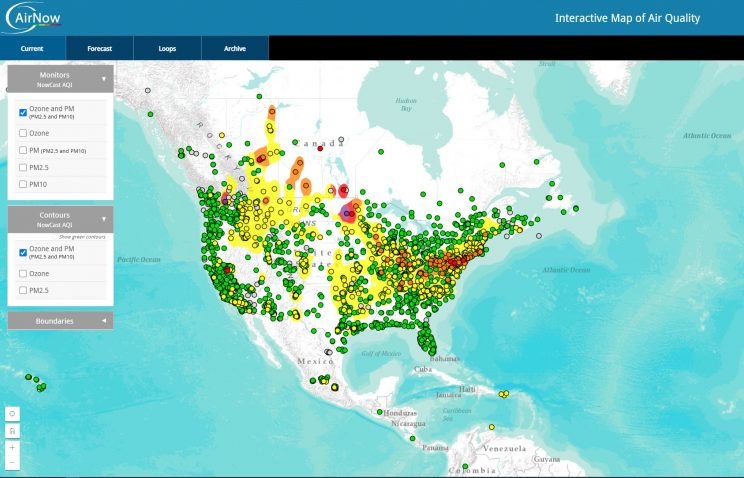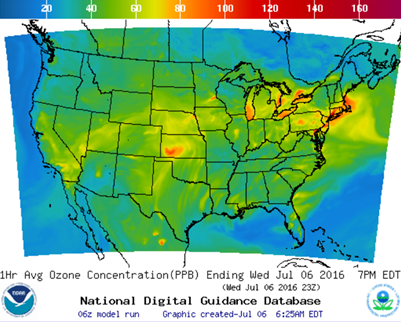Ground-Level Ozone and Fine Particulate Matter Forecasting Research Products

Nationwide air quality forecast maps indicate areas of concern for poor air quality.
While outdoor air quality has improved dramatically over the past few decades, air pollution is still recognized as a major cause of acute and chronic respiratory and cardiovascular problems and annually leads to tens of thousands of premature deaths. The costs of health effects in the United States each year is more than $100 billion. Accurate air quality forecasts enable communities to take actions that can reduce the severity of episodes of poor air quality (e.g., encourage people to telecommute or take mass transit instead of driving). They also enable individuals to take protective actions that limit their own exposure to poor air quality, such as limiting exercise or staying indoors.
The Air Resources Laboratory’s Air Quality Forecasting research helps to ensure that forecast models, run operationally by NOAA’s National Weather Service (NWS), provide consistently high quality forecast products and support air quality planners and managers, air quality forecasters, and the research community. To this end, ARL has led the research, configuration and testing of the National Air Quality Forecasting Capability, an integrated modeling system linking the National Weather Service’s numerical weather prediction model to the NOAA-EPA developed Community Multiscale Air Quality model. As a result of ARL’s research, NOAA has consistently improved operational air quality forecasting products.
The two most important air pollutants of concern are ground-level ozone (O3) and fine particulate matter (PM2.5). These pollutants are linked to serious health impacts, including chronic bronchitis, asthma, and premature deaths. They also contribute to reduced visibility (PM2.5), crop damage (O3), and greater vulnerability to disease in some tree species (O3).
Ozone, O3, is a gas typically produced from other air pollutants reacting in the presence of sunlight. O3 is a major constituent of smog. Motor vehicles, power plants, industrial operations, gasoline vapors, and chemical solvents, as well as natural processes, are emission sources of the pollutants that act to form ground-level O3. Fine particulate matter (PM2.5) is composed of tiny particles with a diameter of 2.5 micrometers or less (or less than 1/30th the width of a human hair). PM2.5 is especially dangerous to human health because fine particles can be inhaled into and accumulate in the respiratory system. PM2.5 is emitted directly into the air from combustion processes (burning of fossil fuels, residential fireplaces, agricultural burning, and fires), volcanic emissions, and windblown dust and can also form in the air as a result of chemical reactions.
ARL has a world class emission modeling team working with scientists in other NOAA laboratories, other federal agencies, and universities to improve air quality forecasting models and to generate data needed to model the significant processes that control the concentrations of ground-level O3.
For More Information:


